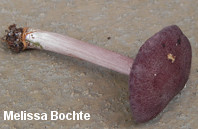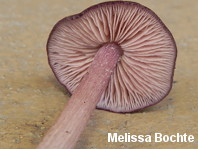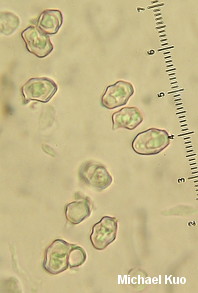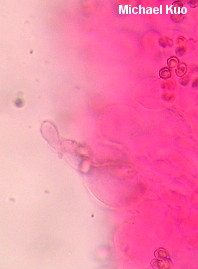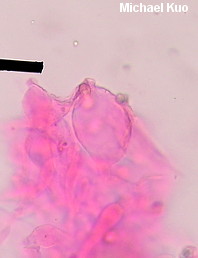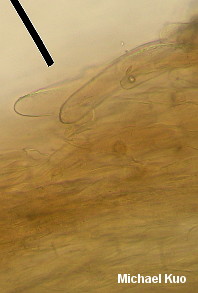| Major Groups > Gilled Mushrooms > Pink-Spored > Entolomatoid Mushrooms > Entoloma violaceum |

|
Entoloma violaceum [Basidiomycota > Agaricales > Entolomataceae > Entoloma . . . ] by Michael Kuo Here is an attractive and distinctive entolomatoid mushroom, particularly common in the southern Appalachian Mountains but also found throughout northeastern North America. When young, the cap and upper stem of Entoloma violaceum are brownish purple, although the cap may later become dark brown, brown, or grayish beige. The cap surface is silky or finely scaly, the young gills are faintly lilac, and the mature gills often develop whitish to beige edges that are paler than the faces. Under the microscope Entoloma violaceum features prominent cheilocystidia and heterodiametric spores. Entoloma violaceum belongs to subgenus Trichopus of Entoloma, in the group of species centered around Entoloma jubatum--and perhaps it is merely a synonym for that species, which was originally described from Europe. But Entoloma jubatum is usually described by European authors as being brown, even when young, and its cheilocystidia are "distinctly capitate, never apiculate or mucronate" (Noordeloos, 1988)--while Entoloma violaceum has cheilocystidia that range from capitate to mucronate, clavate, saccate, or merely cylindric. Description: Ecology: Saprobic; growing gregariously in bare soil or in grassy areas under hardwoods or conifers; summer and fall; apparently widely distributed in the eastern United States. Cap: 1-4 cm; convex with a slightly conic center, becoming broadly convex; dry; finely silky, becoming finely scaly; brownish purple at first, but often maturing to lilac brown, brown, or grayish beige; the margin a little inrolled at first, not becoming lined. Gills: Narrowly attached to the stem; close; faintly lilac at first, becoming pink; edges often somewhat serrated and whitish; short-gills frequent. Stem: 3-8 cm long; 3-5 mm thick; equal; dry; bald or, near the apex finely silky or dotted with tiny scales; purple near the apex when fresh and young, elsewhere whitish to brownish; basal mycelium white. Flesh: Thin; watery whitish to brownish. Odor and Taste: Not distinctive. Chemical Reactions: KOH on cap surface negative. Spore Print: Pink. Microscopic Features: Spores 6.5-9 x 4.5-7 µ; 5- to 6-sided; heterodiametric; smooth; hyaline. Pleurocystidia absent. Cheilocystidia abundant; in young caps varying from lecythiform to capitate or merely clavate; in older caps varying from capitate to mucronate, fusoid-ventricose, or saccate when collapsed; 45-70 x 10-25 µ. Pileipellis a cutis; elements brown to brownish in 10% ammonia, with intracellular pigment. Clamp connections rare or absent. REFERENCES: Murrill, 1917. (Peck, 1873 ["Agaricus cyaneus," illeg. name]; Kauffman, 1918; Hesler, 1967; Weber & Smith, 1985; Lincoff, 1992.) Herb. Kuo 07090803. This site contains no information about the edibility or toxicity of mushrooms. |
© MushroomExpert.Com |
|
Cite this page as: Kuo, M. (2014, February). Entoloma violaceum. Retrieved from the MushroomExpert.Com Web site: http://www.mushroomexpert.com/entoloma_violaceum.html |
